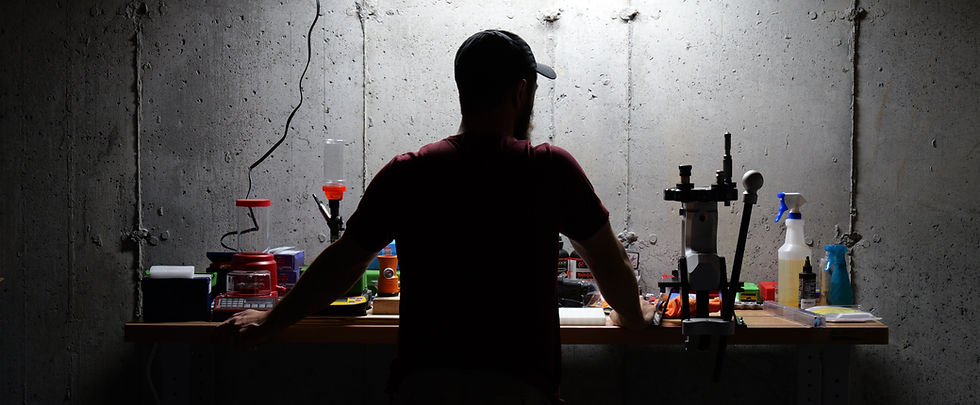Does Primer Seating Depth Matter?
- Reloading_allday

- Jul 21, 2020
- 6 min read
Updated: Jan 18

For the longest time, seating depth on primers and especially primer pocket uniforming, has been discredit by almost all of the shooting community. Unfortunately, this tedious method has been pushed off by many individuals.
Well, I decided to give it a shot to see what would happen.
For the nature of the test, I used a 6.5 Creedmoor with a Criterion Remage, 1/8 twist, 26" barrel, using Berger Hybrid 140's, Lapua brass, CCI 450 primers, and Shooters World Long Rifle. Full length L.E. Wilson Bushing die, CPS Primer seater from Primal Rights, 21st century primer pocket uniformer, 2 thousandth neck tension, and annealed every-time with the induction annealer from AMP.
But, before we get started, let me explain what we are testing here. I first measure each primer pocket of my brass and uniform them all to the same depth. In this case, I uniformed them to -0.1215". I then took the primers themselves and measured those to be exactly 0.119" from the bottom of the cup to the top of the anvil itself by using the Accuracy one primer depth gauge. From here, I then proceeded to alter the "depth" of which the primers were seated.
How Does Primer Seating Depth effect Accuracy?
At the request of Primal Rights, I performed a common ladder test, or OCW, in which I found 38.3 grains to yield an acceptable result. My average velocity was 2667 FPS, with an SD of 4 and an ES of 8. While I also seated all of my primers at -0.002" below flush. My picture below of my grouping at 100 yards, which yielded 0.292 MOA.

Now, after establishing an "OCW" with my "base" of an SD of 4 and an ES of 8, going 2667 FPS on average, I altered my seating depth next. Now, this is the part where most people would call it quits as I have for so many years; because it has been taught for so long that these are the only two basic tests that one should do.
For the seating-depth test, I had produced an even smaller grouping with a slightly better SD and ES. I settled at 2.235" CBTO, with an SD of 2 and an ES of 4, going 2670 on average of three shots. Is this statistically different? I would not say so- Of course, more shots would have to be conducted to see the range of dispersion this particular combo would have.

Does Primer Seating Depth Affect Accuracy?
This might be something that you may want to test for yourself, especially, with the affordability and variety of tools coming out that will allow you to adjust seating depth for primers. Even though this concept is not new, I haven’t found any data out there that supports the concept of primer seating depth, itself and I wanted to get my "feet wet" to see if there was any big statistical changes.
On another note, I will say that I have not tested anything other than the Primal Rights CPS, so I can't guarantee that you will receive accurate results to the one-thousandth. Further, the same goes for primer pocket uniformers. If your primer pocket depths vary, then you will see inconsistent results before seating your primers. If you want to fix that, I'd encourage you to look into the tool I am using because it allows one to adjust the actual depth and is not preset.
Nonetheless, for the seating depth test as instructed, I loaded 3 shot strings at 2.235" CBTO, 38.3 grains like I have been using originally, and only altering the seating depth of the primers themselves via the instructions in order: -0.0000, -0.0005, -0.001, -0.0015, -0.002 below flush. Now, let's dive into the results
-0.0000 SD of 6, ES of 12
-0.0005 SD of 2, ES of 5
-0.001 SD of 1, ES of 2
-0.0015 SD of 8 and ES of 15
-0.002 SD of 4 and ES of 8.
So, what is the big deal about this? This shows that there could be a potential "sweet spot" that you can find when altering your primer seating depth. One may pick the SD of 1 and an ES of 2 at -0.001" under flush with an average speed of 2667 FPS. However, with this only being a sample size of 3 shots, this can be all noise and way more rigorous testing is required to draw any conclusions which we plan on doing at some point in time!

for those whom may ask, In the test I measured to the granule of powder with the RCBS Matchmaster, used an AMP annealer, Primal Rights CPS, L.E. Wilson Hand dies with the Arbor Press that produces, for me, 0.001" runout or less, and the Accuracy One Primer Depth Gauge. Testing with "cheaper" components, did not yield results as good as these which can be due to entirely different factors. So, results will vary on your ability to produce "good" ammo to begin with and having your marksmanship fundamentals down. I would also encourage you to report your results back to me. While this would appear to show a "sweet spot", the SD and ES held within the normal means of variance on three separate days, temperatures of 73-90 degrees Fahrenheit, I can't say that statistically, this is something that is groundbreaking for the shooting community until more people report their conclusions back in to make an analysis of the results from across the board.
However, does primer seating depth matter and affect accuracy? I am not 100% certain. More testing needs to be conducted.
On another note, can you make ammo that is amazing without altering the seating depth of primers? Absolutely, just like you all have. However, I personally am always looking to improve my hand-loading processes more each day and look into new ideas on how one can improve even further.
However, I think everyone could benefit by trying to make sure one last aspect to handloading can be measured for and taken into account.
All in all, give it a shot and see if it works for you!
As always, shoot straight, be safe, and happy reloading!

Blake has been writing reloading articles for three years and helping out within the community to further enhance reloading education. In his free time, he works within the community to help out new hand-loaders by educating them on the many variables that come with this wonderful hobby. His passion is solely based on helping others so that they may pass on that information to future generations, keeping the art of hand-loading alive.
Disclaimer: The content you are about to read is for demonstration purposes only. This includes videos, blog posts, articles, and all information associated with this website. Do not attempt anything you see on this website. Again, these are for demonstration purposes only. If you see reloading data and or comments, please refer to the manufacturer of your choice and contact a technician. We are not responsible for any false data or comments from individuals. Again, this is a demonstration for reloading. Please contact or take classes from certified reloading instructors or contact the manufacturer of your choice. Please, do not attempt to tamper or modify with ammunition or firearms. Seek out a licensed professional or gunsmith. Any information you watch or read on this website must be assumed to have an error and should not be performed. Reloadingallday will not and cannot be held responsible for harm caused to readers and watchers. The material that is covered is for demonstration purposes only. Please be aware that hand-loading and other topics covered are very dangerous and you are within full responsibility and liability for your actions. Reloadingallday is also not responsible or liable for any damage that might be caused due to those who enter this website and read any of our material or watch. Again, this is for demonstration purposes only. By reading this article, you are agreeing that you are responsible for yourself, everyone around you, watchers, viewers, commentators, and fans. You are also agreeing that you are responsible for the safety and property as follows: yourself, everyone around you, watchers, viewers, commentators, and fans. Also, you are accepting that you agree with everything this disclaimer has written down.
Keep in mind that we may receive commissions when you click our links and make purchases so that we are able to cover our costs for reviews. Some items have been sent for testing to create these article, like the CPS. Moreover, the reviews on this website are NEVER paid for so it does not impact our reviews and comparisons. We try our best to keep things fair and balanced, in order to help you make the best choice for you.




New here. What I have't seen/heard in this comment section is, how far the primer moves once fired. If one seats primers too far into the pocket, at ignition, the primer actually moves back to bolt face. If/when this happens, because pressures being high, the movement of said primer loses ground, (newton's law). As this is happening, the explosion is less instrumental forward of the primer. In his instance, as the primer ignition is happening it is also moving backwards thus the actual fire rate is lessened, hence, change in gases to ignite the propellent thus slower burn rate to move projectile forward. It is by no means a hardly noticable outcome yet might be measured as you say by…
Great article.
Outstanding article, Blake.
You’ve been there done that and show us the spot. Personally I’m a Big Fan of primer pocket uniformers and I’ve been using the kit provided by Lyman for a a Year so.
It reduces the Sds even In Pistol calibers also. It’s a great tool not only to improve but also for load developments and other major components tests.
Consistency as the key.
Thank you very much for spend you time educating us.
Happy reloading !
@Reloading_allday I’ll see what my Frankfort perfect prime does. It is a very nice primer and depending on what I find may upgrade it and my Hornady adjustable uniformed. Looking at the mechaniccs of it, I suspect the hornady will work just fine but I’m willing to be wrong if I’m wrong:)
Ted.feasel 21st century primer pocket uniformer. It has a micrometer adjustment.